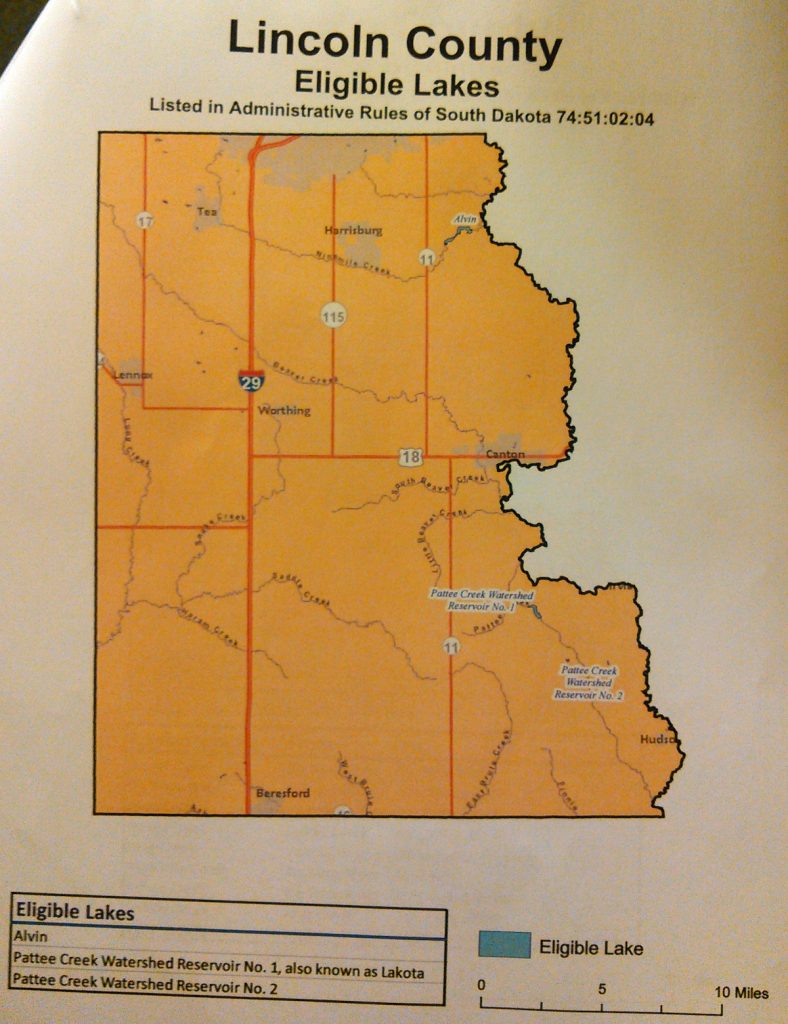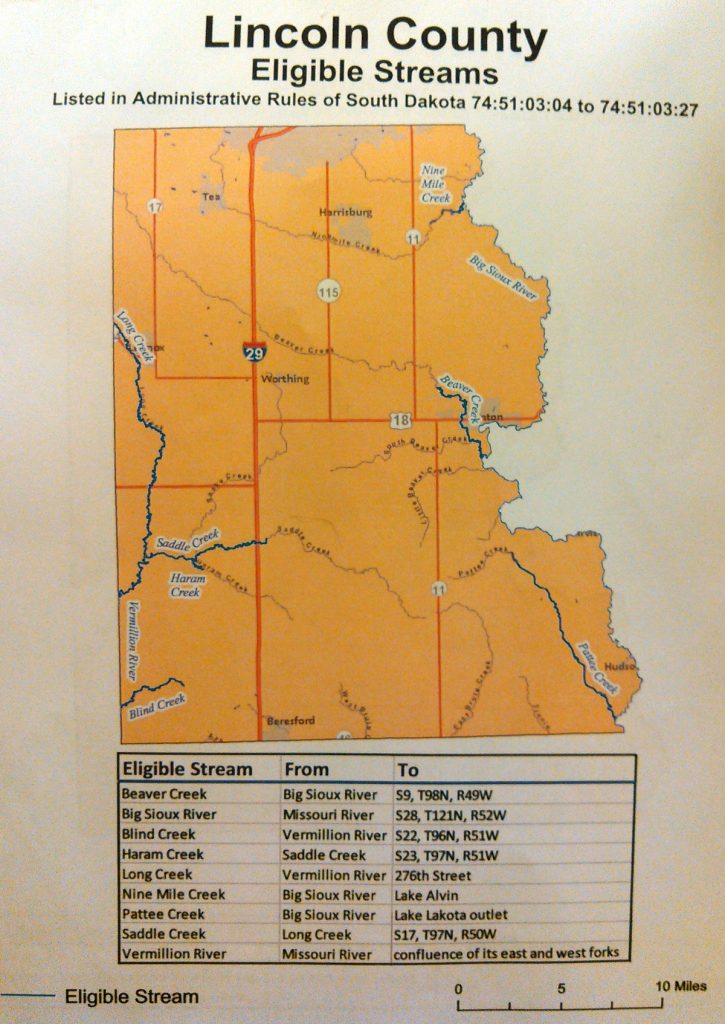Good policy does occasionally make it through the South Dakota Legislature. House Agriculture and Natural Resources took its turn this morning at House Bill 1119, an expansion of the riparian buffer strips program.
Last year, with the Governor’s blessing, the Legislature approved a bill to allow ag land owners to receive property tax relief for planting or keeping acres along certain lakes and streams back in grass and not grazing cattle on them from May through September. Such riparian buffer strips are good for water quality: keeping cattle away keeps poop and bacteria out of the water, and grass helps filter pollution and nutrients than come toward the water from farther up the watershed.
The buffer strip program saw few takers in its first year, because the program is new and because there aren’t a lot of eligible parcels of land relative to the amount of ag land where buffer strips could make a difference for water quality.
My friend Jay Gilbertson, manager of the East Dakota Water Development District, is on hand to help legislators understand why grassy buffer strips are good and why HB 1119 makes it better. Gilbertson showed me these maps of streams and lakes in Lincoln County that are eligible for the riparian buffers strip designation and tax break:


The three named lakes and nine named streams on these two maps are the only spots in Lincoln County eligible for the grassy buffer strip tax relief. The maps show there are a lot more tributaries where more grass could help filter the nutrients affecting water quality downstream. HB 1119 would allow Lincoln County (and all 65 other counties) to add undesignated streams and lakes to the riparian buffer strip program.
That proposal is great for water quality and local control. If a county commission recognizes that cleaner water is good for ag, tourism, and residential quality of life (remember, grassy strips mean less algae and E. coli, less stink, and more swimming and canoeing!), that commission can add more streams to the map and offer tax breaks to more farmers. If a county feels it can’t afford to extend more tax breaks (Gilbertson tells me the tab in Brookings County for 29 enrolled acres this year is $280), it can leave the map at the state minimum.
Everybody appears to like House Bill 1119. Proponents in committee have included the Governor’s Office (stop right there—it passes, right?), the county commissioners’ association, the Department of Agriculture, the Sioux Falls Chamber of Commerce, Dakota Rural Action, the rural water association, the Ikes, the conservation districts, and EDWDD, which has been promoting grassy strips for years. No one has shown up to testify against the bill. As amended in House Local Government, HB 1119 passed through the House and today through Senate Agriculture and Natural Resources with zero no-votes. It’s been placed on consent in both chambers, meaning that when the Senate takes it up in the coming days, barring some surprise, it will be passed without debate because it’s so good a bill that no one has an argument against it.
More grassy buffer strips are good for everybody. It’s good to see that, every now and then, our Legislature manages to be prograssive.
“HB 1119 would allow Lincoln County (and all 65 other counties) to add undesignated streams and lakes to the riparian buffer strip program.”
This appears to be a critical component to this bill. Good for SD. Minnesota’s Gov. Mark Dayton has been struggling against Republicans and farmers to get buffer strips passed for 2-3 years now. Opposition is very strong.
I still think the incentive would be better capitalized upon if the tax reduction was greater. If a landowner is taking land out of production for the public good, we should fairly compensate them for that.
Wayne, I’ll second higher compensation for these conservation efforts. They pay off in public welfare.
Deb, Minnesota has a buffer strips law, and it’s a mandate, unlike South Dakota’s voluntary rebate. Is Dayton pushing changes?
The challenge is, the real financial benefits go downstream and out of state. If we clean up the Big Sioux, Sioux City and Des Moines benefits. If Montana and North Dakota reduce effluent in the Missouri, South Dakota and everyone else benefits. How do we monetize that externality?
Our K-12 schools and universities do the same thing, training all sorts of really smart young people who then flow downstream to make life better in other states. But our local communities still benefit.
The Big Sioux is 419 miles long and the majority of that length is entirely in South Dakota. South Dakota will benefit from a cleaner Big Sioux. The Big Sioux could and should be more of a recreational draw in South Dakota.
It seams that every other year Lake Alvin in Lincoln County has its public beach closed due to E.coli, I wish the designation for 9 Mile Creek extended upstream from Lake Alvin, not just the meaningless portion between it and the Big Sioux, of which the State of South Dakota entirely owns.
http://www.argusleader.com/story/news/2016/06/03/lake-alvin-tests-high-ecoli-closed-swimming/85354756/
Big Sioux-Little Sioux river drainage is towards the Missouri. Des Moines water comes from farther east where most of that drainage goes east and south.
http://iowadrainage.org/Waterways%20Newsletter-2015%20Vol01LR.pdf
Read pages 4 and 5,. They give an overview of DesMoines lawsuit against upstream counties for polluting the water and other legal hurdles that have to be cleared.
Fairly short read.
MN GOP has been working very hard to gut the buffer strips law, minimize enforcement and use it as a bargaining chip in many legislative issues. It’s not a done deal and if MN were to be burdened with an all GOP state govt the buffer law would certainly be dumped.
PlanningStudent knows his maps and water quality. Nine Mile Creek is the first example Jay pointed to on the Lincoln County map. Lake Alvin gets all green and stinky in the summer; grassy buffer strips upstream would make a difference, but nothing upstream is designated for riparian buffer strips. HB1119 would allow Lincoln County to add Nine Mile Creek to the tax-break roster if it wanted to.
The Big Sioux runs through South Dakota’s largest city. Expanding the percentage of watershed where we incentive grassy buffer strips would significantly improve water quality flowing through Sioux Falls.
And yes, it would make water quality better all the way down to New Orleans. Nothing wrong with doing our part.
PlanningStudent, & Cory… I don’t know if buffer strips would help Lake Alvin. There are cattle drinking & eliminating from the southern banks all summer long. If you follow up the creek, you’ll see there is actually a significant amount of grassland buffering it… that may be the problem, though, if cattle are grazed there.
Fair point, Wayne. Local practices may still trump conservation efforts. The state program isn’t a mandate, and neither would be the expanded county designations under HB 1119. Landowners all along the creek could join the program, but if a private landowner keeps grazing cattle in July on the south side of the lake, the efforts won’t make as much of a difference.
But every bit helps, right? And if the county expanded the program, got buy in upstream, and then got data showing X% reduction in E. coli, that could build pressure remaining landowners to take action.